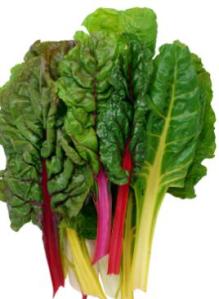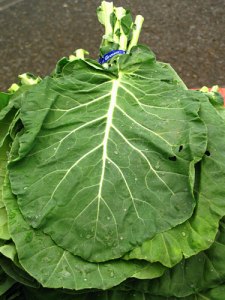I’ve heard many times that “greens” are good for my health and I should eat them often. But I tired of spinach and lettuce very quickly… so then what? What exactly does the term “greens” include? Well, here’s a quick course on knowing your greens. This will give you many options for a variety of greens to include in your regular diet and never have the same thing more than once per week.
 MUSTARD GREENS are a deep green, curly plant. And you guessed it, there is a distinct mustard flavor than can be enhanced or decreased, depending how it is prepared. Mustard greens will help prevent arthritis and anemia, lower LDL cholesterol, battle the onset of heart disease, and offer protection against cancerous growths.
MUSTARD GREENS are a deep green, curly plant. And you guessed it, there is a distinct mustard flavor than can be enhanced or decreased, depending how it is prepared. Mustard greens will help prevent arthritis and anemia, lower LDL cholesterol, battle the onset of heart disease, and offer protection against cancerous growths.
 ROMAINE lettuce grows in a long head of sturdy leaves, which have a firm rib down the center. The interior leaves are more pale in color and are more mild in taste. Romaine is the classic lettuce of choice in Caesar salads and promotes heart health and prevents strokes, as well as cancer. It builds healthy bones, eyes, skin, and mucus membranes.
ROMAINE lettuce grows in a long head of sturdy leaves, which have a firm rib down the center. The interior leaves are more pale in color and are more mild in taste. Romaine is the classic lettuce of choice in Caesar salads and promotes heart health and prevents strokes, as well as cancer. It builds healthy bones, eyes, skin, and mucus membranes.
 ARUGULA is a green leafy plant described as bitter or having a peppery flavor, and is popular in Italian cuisine. This green can be served raw or sautéed; can be added in spaghetti sauce or rice. It’s very versatile and adds a hint of flavor to anything it’s paired with. Arugula inhibits cancer growth and improves immune defenses. It is an excellent choice for building healthy bones.
ARUGULA is a green leafy plant described as bitter or having a peppery flavor, and is popular in Italian cuisine. This green can be served raw or sautéed; can be added in spaghetti sauce or rice. It’s very versatile and adds a hint of flavor to anything it’s paired with. Arugula inhibits cancer growth and improves immune defenses. It is an excellent choice for building healthy bones.
COLLARD GREENS are a form of kale and part of the cabbage family; considered one of the most ancient members of the cabbage family. You will find Collard greens in recipes originating from the Mediterranean, Africa, Asia, and Latin America, and again served raw or cooked. It is very important not to overcook Collard greens. Once overcooked, they will begin to emit an unpleasant sulfur smell, which carries over to other menu items. Collard greens are known to help lower LDL cholesterol, regulate blood sugar, and combat osteoporosis. It also boosts the immune system against viral and bacterial infection.
 SPINACH is a general term that includes many different types and sizes, such as, baby spinach, crinkled leaf spinach, hybrid savoy spinach, and plain leaf spinach. It is known as a flowering plant that will survive in winter temperatures to return the next spring bright and cheery. Spinach comes right to the top as one of the healthiest vegetables available and helps improve red blood cell function, strengthen bones, regulate heart rate and blood pressure, and combats free radicals.
SPINACH is a general term that includes many different types and sizes, such as, baby spinach, crinkled leaf spinach, hybrid savoy spinach, and plain leaf spinach. It is known as a flowering plant that will survive in winter temperatures to return the next spring bright and cheery. Spinach comes right to the top as one of the healthiest vegetables available and helps improve red blood cell function, strengthen bones, regulate heart rate and blood pressure, and combats free radicals.
 SWISS CHARD leaves are always green, but the stalks vary in color and the taste is a bit bitter. You will find Chard in Arab cuisine, and used in salads, soups, and sautéed dishes. I haven’t tried it yet, but understand it’s wonderful with lemon and hazelnuts, which bring out the rich flavor. This beautiful green helps maintain corrective tissue, controls heart rate and blood pressure, as well as sugar levels. It prevents anemia and boosts immunity.
SWISS CHARD leaves are always green, but the stalks vary in color and the taste is a bit bitter. You will find Chard in Arab cuisine, and used in salads, soups, and sautéed dishes. I haven’t tried it yet, but understand it’s wonderful with lemon and hazelnuts, which bring out the rich flavor. This beautiful green helps maintain corrective tissue, controls heart rate and blood pressure, as well as sugar levels. It prevents anemia and boosts immunity.
 TURNIP GREENS are called this for a reason. They are the large leaves of the turnip plant. So you can incorporate the turnips into your diet too… or simply use the green leaves, which are often found in classic Southern dishes and considered a comfort food when served with other traditional pork-seasoned leafy greens. Turnip greens enhance collagen synthesis, build healthy bones, combat anemia, and boost immune defenses.
TURNIP GREENS are called this for a reason. They are the large leaves of the turnip plant. So you can incorporate the turnips into your diet too… or simply use the green leaves, which are often found in classic Southern dishes and considered a comfort food when served with other traditional pork-seasoned leafy greens. Turnip greens enhance collagen synthesis, build healthy bones, combat anemia, and boost immune defenses.
 ICEBERG lettuce is probably what most of us remember eating as we were growing up. It’s inexpensive and tastes good in salads or on hamburgers, and is sturdy enough to remain crispy. Iceberg, although lowest of all leafy greens nutritionally, combats anemia, heart disease, and age-related illnesses. It works well mixed with other greens.
ICEBERG lettuce is probably what most of us remember eating as we were growing up. It’s inexpensive and tastes good in salads or on hamburgers, and is sturdy enough to remain crispy. Iceberg, although lowest of all leafy greens nutritionally, combats anemia, heart disease, and age-related illnesses. It works well mixed with other greens.
 KALE is the most nutrient-dense green-leafed vegetable available. The flavor is delicious, but nutritional qualities are enhanced when steamed. With that said, you must try kale chips, which is baking this leaf into a crispy chip that tastes delicious. You will find Kale in curly, ornamental, or dinosaur varieties. It aids in blood clotting, promotes healthy vision and retinal functioning, and fights cancer.
KALE is the most nutrient-dense green-leafed vegetable available. The flavor is delicious, but nutritional qualities are enhanced when steamed. With that said, you must try kale chips, which is baking this leaf into a crispy chip that tastes delicious. You will find Kale in curly, ornamental, or dinosaur varieties. It aids in blood clotting, promotes healthy vision and retinal functioning, and fights cancer.
